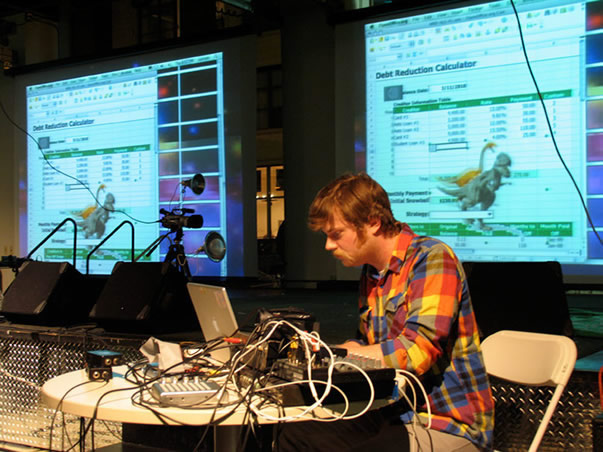WINDOWS RAINBOWS & DINOS
Jon Satrom's prepared desktop realtime performance: Windows, Rainbows, & Dinos was a part of the CAA 2010 Live Cinema Summit at Columbia College in Chicago. This is a recording of the realtime performance.
jonsatrom.com
Other performances that evening included: Noisefold, Barbara Lattanzi, Sabine Gruffat & Bill Brown, Robert Martin, Chris Kubick, Jon Satrom, Potter-Belmar Labs, DatalRJ, Black and Jones, Jon Cates, and Alessandro Imperato, hosted by the New Media Caucus, a College Art Association Affiliated Society.
Sisyphian Software by Alessandro Imperato Ph.D.
SCAD Atlanta: Savannah College of Art and Design
newmediacaucus.org/wp/live-cinema-summit-a-review-of-real-time-audio-visual-performance/
Jon Satrom performed an intriguing deconstruction of the Mac OSX interface and Microsoft software packages.[4] As a programmer and artist, he uses his abilities to break down the visual interface of what we have come to accept as the access portal to the functions of ‘easy-to-use’ domestic consumer digital software. The act of interfering with this visual language throws up all kinds of issues relating to the power of software companies such as Apple and Microsoft, how they control the way we use digital technology, and the limitations that are created by this closed-source programming environment. The audience gasped with delight as the Mac OSX system began to malfunction and copies of files, folders, blips and noise duplicated and multiplied like a cancer of O’s and 1’s over a desktop stage. The surprising mid-point appearance of two gif-style animated dinosaurs having sex was a hilarious Monty Python-esque surreal injection into the sterile visuality of the software interface. Satrom’s art is a subtle critique and parody of the day-to-day struggle the user experiences when trying to make their computer work for them. The Sisyphean comic-tragedy of attempts at working to control technology can lead to a realization that in the end, it’s all futile because a new function, software variation or re-design will be created to confuse, commoditize and add complexity to the process of getting simple tasks done. Through the artist’s play, work was parodied and fore-grounded. Ironically, the skill and knowledge to perform such an act of futility and pathos requires consummate mastery. The old adage that to pretend to do something badly takes great skill is obvious in Satrom’s ability to transfix the audience on the edge of possible failure. Satrom humanized an otherwise cold machine – this is the human condition of our relationship to technology – as well as a task that many artists who use digital media have to deal with. In his Q&A Satrom claimed that he was influenced by 1990’s net artists such as Jodi and Nato software authored by the Netochka Nezvanova collective, whose website deconstructed computer interfaces and showed the audience how the magician, or wizard behind the screen works.[5] Satrom’s work it is an effective application of Brechtian techniques of ‘making strange’ in revealing the means of digital production and reproduction.
